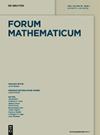Normalized solutions for the fractional Schrödinger equation with combined nonlinearities
IF 0.9
3区 数学
Q1 MATHEMATICS
Shengbing Deng, Qiaoran Wu
求助PDF
{"title":"Normalized solutions for the fractional Schrödinger equation with combined nonlinearities","authors":"Shengbing Deng, Qiaoran Wu","doi":"10.1515/forum-2023-0424","DOIUrl":null,"url":null,"abstract":"In this paper, we study the normalized solutions for the following fractional Schrödinger equation with combined nonlinearities <jats:disp-formula-group> <jats:disp-formula> <jats:alternatives> <m:math xmlns:m=\"http://www.w3.org/1998/Math/MathML\"> <m:mrow> <m:mo>{</m:mo> <m:mtable columnspacing=\"0pt\" rowspacing=\"0pt\"> <m:mtr> <m:mtd columnalign=\"right\"> <m:mrow> <m:msup> <m:mrow> <m:mo stretchy=\"false\">(</m:mo> <m:mrow> <m:mo>-</m:mo> <m:mi mathvariant=\"normal\">Δ</m:mi> </m:mrow> <m:mo stretchy=\"false\">)</m:mo> </m:mrow> <m:mi>s</m:mi> </m:msup> <m:mo></m:mo> <m:mi>u</m:mi> </m:mrow> </m:mtd> <m:mtd columnalign=\"left\"> <m:mrow> <m:mi /> <m:mo>=</m:mo> <m:mrow> <m:mrow> <m:mi>λ</m:mi> <m:mo></m:mo> <m:mi>u</m:mi> </m:mrow> <m:mo>+</m:mo> <m:mrow> <m:mi>μ</m:mi> <m:mo></m:mo> <m:msup> <m:mrow> <m:mo fence=\"true\" stretchy=\"false\">|</m:mo> <m:mi>u</m:mi> <m:mo fence=\"true\" stretchy=\"false\">|</m:mo> </m:mrow> <m:mrow> <m:mi>q</m:mi> <m:mo>-</m:mo> <m:mn>2</m:mn> </m:mrow> </m:msup> <m:mo></m:mo> <m:mi>u</m:mi> </m:mrow> <m:mo>+</m:mo> <m:mrow> <m:msup> <m:mrow> <m:mo fence=\"true\" stretchy=\"false\">|</m:mo> <m:mi>u</m:mi> <m:mo fence=\"true\" stretchy=\"false\">|</m:mo> </m:mrow> <m:mrow> <m:mi>p</m:mi> <m:mo>-</m:mo> <m:mn>2</m:mn> </m:mrow> </m:msup> <m:mo></m:mo> <m:mi>u</m:mi> </m:mrow> </m:mrow> </m:mrow> </m:mtd> <m:mtd /> <m:mtd columnalign=\"right\"> <m:mrow> <m:mrow> <m:mtext>in </m:mtext> <m:mo></m:mo> <m:msup> <m:mi>ℝ</m:mi> <m:mi>N</m:mi> </m:msup> </m:mrow> <m:mo>,</m:mo> </m:mrow> </m:mtd> </m:mtr> <m:mtr> <m:mtd columnalign=\"right\"> <m:mrow> <m:mstyle displaystyle=\"true\"> <m:msub> <m:mo largeop=\"true\" symmetric=\"true\">∫</m:mo> <m:msup> <m:mi>ℝ</m:mi> <m:mi>N</m:mi> </m:msup> </m:msub> </m:mstyle> <m:mrow> <m:mpadded width=\"+1.7pt\"> <m:msup> <m:mi>u</m:mi> <m:mn>2</m:mn> </m:msup> </m:mpadded> <m:mo></m:mo> <m:mrow> <m:mo>𝑑</m:mo> <m:mi>x</m:mi> </m:mrow> </m:mrow> </m:mrow> </m:mtd> <m:mtd columnalign=\"left\"> <m:mrow> <m:mrow> <m:mi /> <m:mo>=</m:mo> <m:msup> <m:mi>a</m:mi> <m:mn>2</m:mn> </m:msup> </m:mrow> <m:mo>,</m:mo> </m:mrow> </m:mtd> </m:mtr> </m:mtable> </m:mrow> </m:math> <jats:graphic xmlns:xlink=\"http://www.w3.org/1999/xlink\" xlink:href=\"graphic/j_forum-2023-0424_eq_0161.png\" /> <jats:tex-math>\\displaystyle\\left\\{\\begin{aligned} \\displaystyle{}(-\\Delta)^{s}u&% \\displaystyle=\\lambda u+\\mu\\lvert u\\rvert^{q-2}u+\\lvert u\\rvert^{p-2}u&&% \\displaystyle\\phantom{}\\text{in }\\mathbb{R}^{N},\\\\ \\displaystyle\\int_{\\mathbb{R}^{N}}u^{2}\\,dx&\\displaystyle=a^{2},\\end{aligned}\\right.</jats:tex-math> </jats:alternatives> </jats:disp-formula> </jats:disp-formula-group> where <jats:inline-formula> <jats:alternatives> <m:math xmlns:m=\"http://www.w3.org/1998/Math/MathML\"> <m:mrow> <m:mn>0</m:mn> <m:mo><</m:mo> <m:mi>s</m:mi> <m:mo><</m:mo> <m:mn>1</m:mn> </m:mrow> </m:math> <jats:inline-graphic xmlns:xlink=\"http://www.w3.org/1999/xlink\" xlink:href=\"graphic/j_forum-2023-0424_eq_0263.png\" /> <jats:tex-math>{0<s<1}</jats:tex-math> </jats:alternatives> </jats:inline-formula>, <jats:inline-formula> <jats:alternatives> <m:math xmlns:m=\"http://www.w3.org/1998/Math/MathML\"> <m:mrow> <m:mi>N</m:mi> <m:mo>></m:mo> <m:mrow> <m:mn>2</m:mn> <m:mo></m:mo> <m:mi>s</m:mi> </m:mrow> </m:mrow> </m:math> <jats:inline-graphic xmlns:xlink=\"http://www.w3.org/1999/xlink\" xlink:href=\"graphic/j_forum-2023-0424_eq_0318.png\" /> <jats:tex-math>{N>2s}</jats:tex-math> </jats:alternatives> </jats:inline-formula>, <jats:inline-formula> <jats:alternatives> <m:math xmlns:m=\"http://www.w3.org/1998/Math/MathML\"> <m:mrow> <m:mn>2</m:mn> <m:mo><</m:mo> <m:mi>q</m:mi> <m:mo><</m:mo> <m:mi>p</m:mi> <m:mo>=</m:mo> <m:msubsup> <m:mn>2</m:mn> <m:mi>s</m:mi> <m:mo>*</m:mo> </m:msubsup> <m:mo>=</m:mo> <m:mfrac> <m:mrow> <m:mn>2</m:mn> <m:mo></m:mo> <m:mi>N</m:mi> </m:mrow> <m:mrow> <m:mi>N</m:mi> <m:mo>-</m:mo> <m:mrow> <m:mn>2</m:mn> <m:mo></m:mo> <m:mi>s</m:mi> </m:mrow> </m:mrow> </m:mfrac> </m:mrow> </m:math> <jats:inline-graphic xmlns:xlink=\"http://www.w3.org/1999/xlink\" xlink:href=\"graphic/j_forum-2023-0424_eq_0281.png\" /> <jats:tex-math>{2<q<p=2_{s}^{*}=\\frac{2N}{N-2s}}</jats:tex-math> </jats:alternatives> </jats:inline-formula>, <jats:inline-formula> <jats:alternatives> <m:math xmlns:m=\"http://www.w3.org/1998/Math/MathML\"> <m:mrow> <m:mrow> <m:mi>a</m:mi> <m:mo>,</m:mo> <m:mi>μ</m:mi> </m:mrow> <m:mo>></m:mo> <m:mn>0</m:mn> </m:mrow> </m:math> <jats:inline-graphic xmlns:xlink=\"http://www.w3.org/1999/xlink\" xlink:href=\"graphic/j_forum-2023-0424_eq_0421.png\" /> <jats:tex-math>{a,\\mu>0}</jats:tex-math> </jats:alternatives> </jats:inline-formula> and <jats:inline-formula> <jats:alternatives> <m:math xmlns:m=\"http://www.w3.org/1998/Math/MathML\"> <m:mrow> <m:mi>λ</m:mi> <m:mo>∈</m:mo> <m:mi>ℝ</m:mi> </m:mrow> </m:math> <jats:inline-graphic xmlns:xlink=\"http://www.w3.org/1999/xlink\" xlink:href=\"graphic/j_forum-2023-0424_eq_0350.png\" /> <jats:tex-math>{\\lambda\\in\\mathbb{R}}</jats:tex-math> </jats:alternatives> </jats:inline-formula> is a Lagrange multiplier. Since the existence results for <jats:inline-formula> <jats:alternatives> <m:math xmlns:m=\"http://www.w3.org/1998/Math/MathML\"> <m:mrow> <m:mi>p</m:mi> <m:mo><</m:mo> <m:msubsup> <m:mn>2</m:mn> <m:mi>s</m:mi> <m:mo>*</m:mo> </m:msubsup> </m:mrow> </m:math> <jats:inline-graphic xmlns:xlink=\"http://www.w3.org/1999/xlink\" xlink:href=\"graphic/j_forum-2023-0424_eq_0455.png\" /> <jats:tex-math>{p<2_{s}^{*}}</jats:tex-math> </jats:alternatives> </jats:inline-formula> have been proved, using an approximation method, that is, let <jats:inline-formula> <jats:alternatives> <m:math xmlns:m=\"http://www.w3.org/1998/Math/MathML\"> <m:mrow> <m:mi>p</m:mi> <m:mo>→</m:mo> <m:msubsup> <m:mn>2</m:mn> <m:mi>s</m:mi> <m:mo>*</m:mo> </m:msubsup> </m:mrow> </m:math> <jats:inline-graphic xmlns:xlink=\"http://www.w3.org/1999/xlink\" xlink:href=\"graphic/j_forum-2023-0424_eq_0460.png\" /> <jats:tex-math>{p\\rightarrow 2_{s}^{*}}</jats:tex-math> </jats:alternatives> </jats:inline-formula>, we obtain several existence results. Moreover, we analyze the asymptotic behavior of solutions as <jats:inline-formula> <jats:alternatives> <m:math xmlns:m=\"http://www.w3.org/1998/Math/MathML\"> <m:mrow> <m:mi>μ</m:mi> <m:mo>→</m:mo> <m:mn>0</m:mn> </m:mrow> </m:math> <jats:inline-graphic xmlns:xlink=\"http://www.w3.org/1999/xlink\" xlink:href=\"graphic/j_forum-2023-0424_eq_0386.png\" /> <jats:tex-math>{\\mu\\rightarrow 0}</jats:tex-math> </jats:alternatives> </jats:inline-formula> and μ goes to its upper bound.","PeriodicalId":12433,"journal":{"name":"Forum Mathematicum","volume":"190 1","pages":""},"PeriodicalIF":0.9000,"publicationDate":"2024-01-31","publicationTypes":"Journal Article","fieldsOfStudy":null,"isOpenAccess":false,"openAccessPdf":"","citationCount":"0","resultStr":null,"platform":"Semanticscholar","paperid":null,"PeriodicalName":"Forum Mathematicum","FirstCategoryId":"100","ListUrlMain":"https://doi.org/10.1515/forum-2023-0424","RegionNum":3,"RegionCategory":"数学","ArticlePicture":[],"TitleCN":null,"AbstractTextCN":null,"PMCID":null,"EPubDate":"","PubModel":"","JCR":"Q1","JCRName":"MATHEMATICS","Score":null,"Total":0}
引用次数: 0
引用
批量引用
Abstract
In this paper, we study the normalized solutions for the following fractional Schrödinger equation with combined nonlinearities { ( - Δ ) s u = λ u + μ | u | q - 2 u + | u | p - 2 u in ℝ N , ∫ ℝ N u 2 𝑑 x = a 2 , \displaystyle\left\{\begin{aligned} \displaystyle{}(-\Delta)^{s}u&% \displaystyle=\lambda u+\mu\lvert u\rvert^{q-2}u+\lvert u\rvert^{p-2}u&&% \displaystyle\phantom{}\text{in }\mathbb{R}^{N},\\ \displaystyle\int_{\mathbb{R}^{N}}u^{2}\,dx&\displaystyle=a^{2},\end{aligned}\right. where 0 < s < 1 {0<s<1} , N > 2 s {N>2s} , 2 < q < p = 2 s * = 2 N N - 2 s {2<q<p=2_{s}^{*}=\frac{2N}{N-2s}} , a , μ > 0 {a,\mu>0} and λ ∈ ℝ {\lambda\in\mathbb{R}} is a Lagrange multiplier. Since the existence results for p < 2 s * {p<2_{s}^{*}} have been proved, using an approximation method, that is, let p → 2 s * {p\rightarrow 2_{s}^{*}} , we obtain several existence results. Moreover, we analyze the asymptotic behavior of solutions as μ → 0 {\mu\rightarrow 0} and μ goes to its upper bound.
具有组合非线性的分数薛定谔方程的归一化解
本文研究了以下具有组合非线性的分数薛定谔方程的归一化解 { ( - Δ ) s u = λ u + μ | u | q - 2 u + | u | p - 2 u in ℝ N , ∫ ℝ N u 2 𝑑 x = a 2 , \displaystyle\left\{\begin{aligned}\(-\Delta)^{s}u&% \displaystyle=\lambda u+\mu\lvert u\rvert^{q-2}u+\lvert u\rvert^{p-2}u&&;% \displaystyle\phantom{}\text{in }\mathbb{R}^{N},\\displaystyle\int_{\mathbb{R}^{N}}u^{2}\,dx&\displaystyle=a^{2},\end{aligned}\right. 其中,0 < s < 1 {0<s<1} , N > 2 s {N>2s} , 2 < q < 1 {0<s<1}. 2 < q < p = 2 s * = 2 N N - 2 s {2<q<p=2_{s}^{*}=frac{2N}{N-2s}} , a , μ > 0 {a,\mu>0} 且 λ∈ ℝ {\lambda\in\mathbb{R}} 是拉格朗日乘数。由于 p< 2 s * {p<2_{s}^{*}}的存在性结果已被证明,因此使用近似法,即让 p → 2 s * {p\rightarrow 2_{s}^{*}} ,我们可以得到几个存在性结果。 ,我们得到了几个存在性结果。此外,我们还分析了当μ → 0 {\mu\rightarrow 0}和μ达到其上限时解的渐近行为。
本文章由计算机程序翻译,如有差异,请以英文原文为准。

 求助内容:
求助内容: 应助结果提醒方式:
应助结果提醒方式:


